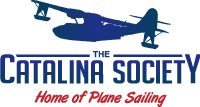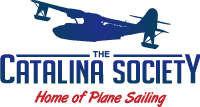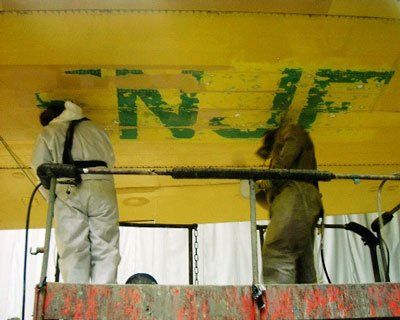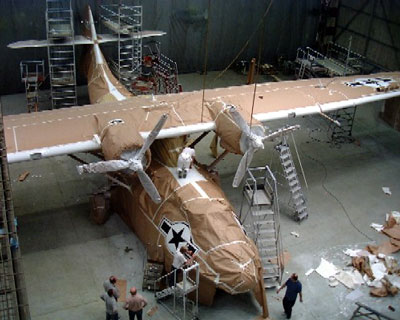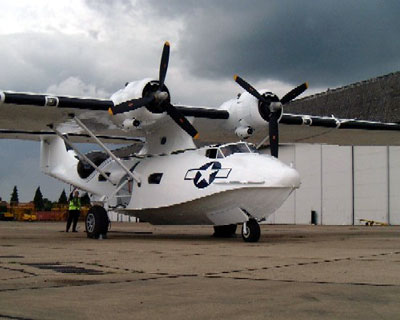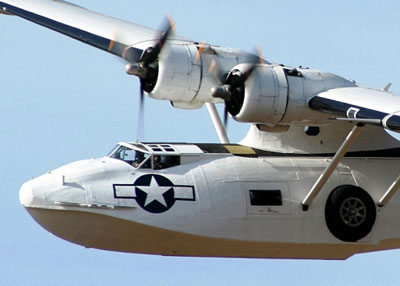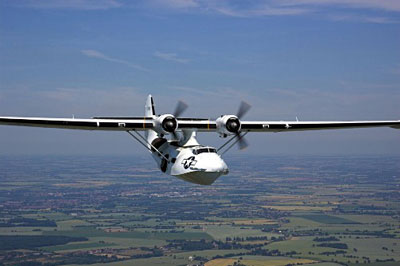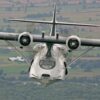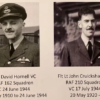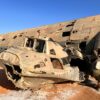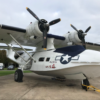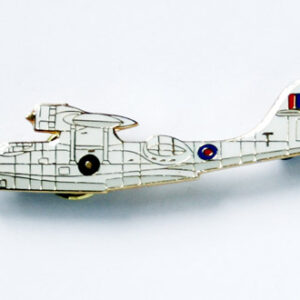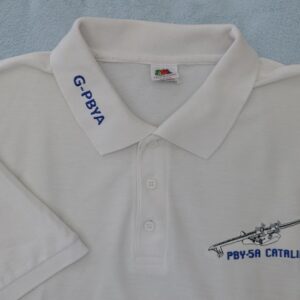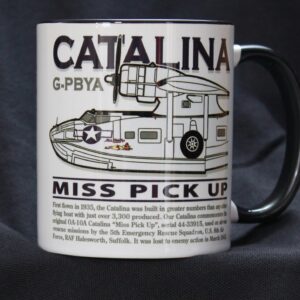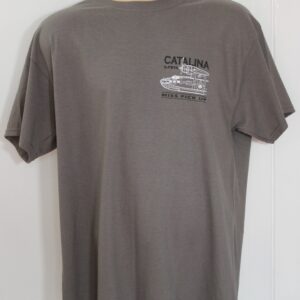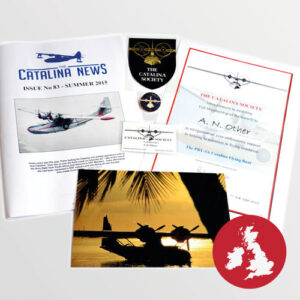G-PBYA was originally ordered for the Royal Canadian Air Force as a Canso A amphibian, basically equivalent to the US Navy PBY-5A. It was built by Canadian Vickers at Cartierville, Quebec and was allocated their constructors number CV-283 before adopting the RCAF serial 11005. It was taken on charge by the air force on 27 October 1943 and initially saw service with 9 (Bomber Reconnaissance) Squadron at Bella Bella on the British Columbia coast between Vancouver and Prince Rupert. It was on their inventory from November to the following August. 9 Squadron had been based at Bella Bella for some time prior to the arrival of Cansos, having operated Supermarine Stranraers there. The Cansos were mainly operated from water despite their amphibious undercarriages and were used on day and night patrols, looking out for enemy submarines. By mid-1944, the threat of a Japanese invasion of Western Canada had receded and it was decided to disband 9 Squadron and close the station at Bella Bella. The Cansos, including 11005, were flown to Alliford Bay in the Queen Charlotte Islands, also in British Columbia, and transferred to 7 (BR) Squadron in August. The job was the same – anti-submarine patrols mostly – and 11005 remained with 7 Sqn until it too was disbanded on 25 July 1945. During this period of 11005’s service, it would have flown with an overall matt white hull and upper surfaces, the lower hull being gloss white.
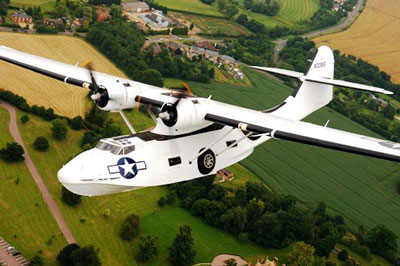
Photo: Richard Paver, near Duxford, July 2005
With the war over, 11005 was no longer required in its originally intended role and it entered a period of storage at Moose Jaw before being converted to a freighter in 1948. A number of other RCAF Cansos were similarly converted and records show that they were known, at least on paper, as Canso 2Fs. Subsequently, 11005 flew with 413 Survey (Transport) squadron out of Rockcliffe, Ontario and, later, with 121 CU/CR Flight. 413 (Tusker) Squadron had originally flown Catalinas in the North Atlantic and Indian Ocean theatres during WWII. Reformed after the war as 413 (PR) Squadron, it flew photographic reconnaissance missions surveying the Arctic regions, search-and-rescue and flood relief supply flights. In April 1949, it was re-designated 413 S(T) Squadron until, at the end of October 1950, it was disbanded. 11005 then passed on to 121 (Search & Rescue) Flight at Sea Island, Vancouver with whom it would have carried the hull code QT-005. It was finally struck off military charge on 25 May 1961, having been stored at Vulcan, Alberta, and was disposed of by the Crown Assets Disposal Corp to the commercial company Frontier Air Transport based in nearby Calgary. Prior to this, it had lost both its bow turret and side blisters as part of its post-war conversion. 11005 was about to embark on a new and lengthy civilian career!

RCAF Canso A serial 11005 shown in post-war service with 121 (S&R) Flight Photo: David Legg Collection
It seems that although the sale of 11005 was to Frontier Air Transport, it was intended for a company called CANSPEC who were intending to convert it, and four other Cansos acquired at the same time, to fire fighting water bombers. A contemporary CANSPEC brochure is illustrated with a Catalina/Canso equipped with under-wing tanks although it also states that their aircraft were available for pest control, general freight and fuel hauling and photographic/geophysical survey. 11005 was registered CF-NJF for its ferry flight to Calgary. It is not certain what came of CANSPEC’s plans but CF-NJF was in due course converted to carry internal tanks by Field Aviation and was taken on by the well-known Catalina/Canso operator Kentings. In addition to carrying Kenting titles, it was also chartered to the French operator Protection Civile and flew with them for a number of fire fighting seasons during the mid- to late-1960s, based at Marseille. It carried a blue rear hull band and was known by the call-sign Pelican Bleu. At first registered F-ZBAY, it later flew as F-ZBBD although it seems to have reverted to its Canadian marks each time it returned to Canada.

Taken in October 1972, CF-NJF was being operated by Kentings as a water bombing firefighter Photo: Tom Singfield Collection
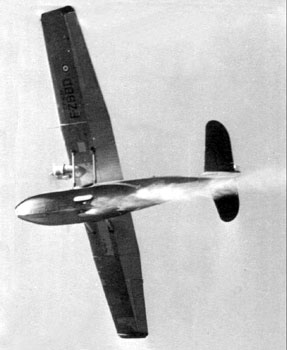
Releasing water
This photograph was taken during one of CF-NJF’s sojourns fighting fires in France with the Protection Civile. It carried dual Canadian and French markings, the latter being F-ZBBD
Photo: via Bernard Servieres
In 1974, it joined Norcanair, a fire fighting company based at Prince Albert in Saskatchewan and it’s predominantly natural metal livery was brightened up with the addition of a white rear hull and tail with vivid orange stripes on the bow, top of the vertical tail, wingtip floats and around the rear hull. It carried the fleet number 14 in large orange numerals below the cockpit. A few years later, its registration was amended from CF-NJF to C-FNJF in accordance with new Canadian practice.

C-FNJF in the colours of Norcanair. This photograph was taken in June 1980 Photo: Tom Singfield Collection
Around 1980, it was taken over by the Province of Saskatchewan at La Ronge who continued to use it as a water bomber within their own fleet of fire fighting aircraft including two other Cansos and Canadair CL-215s. It acquired a new yellow overall livery with green trim and fleet number 7. On one memorable occasion, all three Cansos flew together at an airshow and performed a simultaneous, formation water drop!

In what looks like newly applied Saskatchewan colours, C-FNJF is seen her in Toronto during May 1981 Photo: Caz Caswell

C-FNJF was stored at Nanaimo on Vancouver Island for some time where conditions were somewhat Spartan!
By the late-1990s, the Saskatchewan Cansos had been disposed of and two of them including C-FNJF were acquired by Hicks & Lawrence and stored for a while at St Thomas, Ontario. They were then ferried to Nanaimo on Vancouver Island where Catalina Aero Services were engaged to convert them into passenger carrying aircraft for tourist flights in Zimbabwe. This venture never got off the ground and both Cansos remained at Nanaimo where they were put up for sale. Stored in the open for some time, C-FNJF was eventually purchased by Plane Sailing Air Displays. Although the proposal to use the Cansos in Africa did not come to anything, conversion work was carried out. Not only was the water-bombing equipment removed and seating put in its place but one-piece smoked perspex blisters with hydraulic operation were installed in the rear hull to give passengers a panoramic view. A hydraulic airstair was put into the rear hull to make entry and exit easier. When advertised for sale, the particulars for C-FNJF stated that the airframe had flown 12,829 hours.
Plane Sailing’s search for a Catalina to replace its original aircraft had been a long one, not because there is a shortage of available Catalinas – there are always a few for sale at any one time for the right price – but because the owners wanted to acquire one that was right for them. This meant an aircraft that had a sound airframe, preferably with rear hull blisters, an air stair at the rear and scope for a passenger interior. After a number of aircraft were rejected the choice fell on C-FNJF at Nanaimo.
With the decision to acquire C-FNJF made, there followed a long period of work on the aircraft to make it ready not only for the long ferry flight to the UK but also for ongoing operations. This process became somewhat protracted as various modifications made to the airframe required clearance by Transport Canada. Eventually, however, all was ready and, following a period of test and familiarisation flights, C-FNJF left Nanaimo on 1st March 2004. Over the following month, the delivery route took in a number of States before entering Canada again and then crossing the Atlantic. The exact route, planned to avoid high ground and adverse weather, took in Port Angeles, Wa; Santa Rosa, Ca; Castle AFB, Ca; Mesa (Phoenix), Az; Midland, Tx; Mineral Wells, Tx; Montgomery, Al; Greensboro, NC; Atlantic City, NJ; Bangor, Maine and St John’s, Newfoundland. A first attempt to fly from St John’s to Santa Maria in the Azores had to be abandoned after several hours flying because of a strong, un-forecast headwind. A week later, a second attempt was made, this time successfully, the destination being Shannon in Southern Ireland, reached after nearly thirteen hours in the air and in temperatures as low as minus 28 degrees Centigrade!
